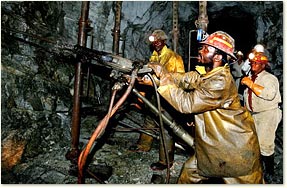
Nelson Rolihlahla ("Troublemaker") Mandela was born at the 18th July 1918 in the east part of Transkei as a “Xhosa“, a tribe in South Africa which had a lot of conflicts with other tribes. The Transkei was a region which was colonized by the british people.
He had a lot of brothers and sisters. His father was a big member of the royal house of this tribe. Mandela had a great life between the bushes and trees. But after his dad had a conflict with the white people, he and his mom lost this area. A few years later, his father died and Nelson accepted the office of the district leader. He went through a lot of colleges and realized that there were differences between black and white humans. In this time, he got to know a lot of persons, who played a big role in his life, like Oliver Tambo, an important political figure.
In Fort Hare, he became a member of the student movement and protested against the awful conditions in the college. Nearly, he was chucked out of this academy, but some new circumstances gave him a new perspective. His regent, who raised him four years long, wanted to marry him. But he didn't agree with this decision and fled to Johannesburg, to his cousin. On this way, he got to know Walter Sisulu, who enabled Mandela studies in law. Meanwhile, he met a judge, who defended him in his main process.
In 1942, Mandela joined into the ANC, after he started his fight against the british regime and the white domninanmce. He found a youth organsitation which should support the aims of the party.
After the White-people-party won the election of South Africa, the apartheit was introduced. It's also known as the racial segregation, which seperated the black from the white ones. The white people took away the rights and homes of the black. They used them as slaves and workers in mines. The educational opportunities for the black people were different to the white humans. But if anyone took action against the white people, they took them into prison or hurt them.
In this time, Mandela was one of the heads of the ANC and bit by bit, he exerted himself into the fight against the apartheit. Because meanwhile, the regime decided that the black inhabitants shouldn't possess any free rights.
After a group of demonstrators were shot by the soldiers in 1960, the ANC offered that they went on ahead with weapons against the South African army.
In 1961, he became the leader of the armed wing of the ANC. They carried out a lot of operations and came often in conflict with the soldiers.
One year later, the white regime arrested Nelson Mandela and some other rebels and took them into prison. At the 12th June 1964 in the "Riviona-process", the judge decided to bring them into prison on Robben Island for the rest of their life.
The gouvernment offered Nelson of leaving the prison by stopping the fight against the apartheit. But he refused the offer and rested into prison till the 11 th february 1990, when Frederik de Klerk gave him back his liberty and lifted the ban of he hunt against the ANC. While Mandela was in prison, there were some big fights in South Africa. The population made a lot of demonstrations. At the 16th Juni 1976, there was a big rebellion of students and pupils. About 500 people were killed by the soldiers.
Four years later, the party of Mandela won the vote and they were represented by Nelson Mandela, the first president of South Africa till the end of the apartheit.
At the 9th Mai 1993, Mandela became the president of South Africa and he hold his office till december 1997. In these years, he tried to repeal the apartheit and took the population into a better future with basic rights and a democratic politic. He was the first man who rebeled against the white regime and led the nation into a good political system which helped them in every way. There are still big problems like the high criminality, but I think, they are in a good way of coming closer to a liberal and free political system. South Africa is such a gread country, has so many nice areas and is very rich in raw materials. But now, they are in the position of bringing themself into a big power of the world, especially in the economic. Mandela eliminated the apartheit out if his country. I hope, every nation support this plan. I hope, South Africa cling starwartly at their aims and continue the plan of Mandela, the biggest hero for me, for South Africa and probably for the world.

 roblem there.
roblem there.















































